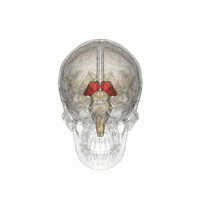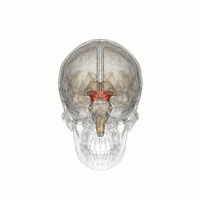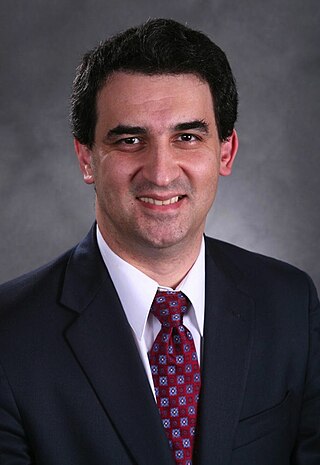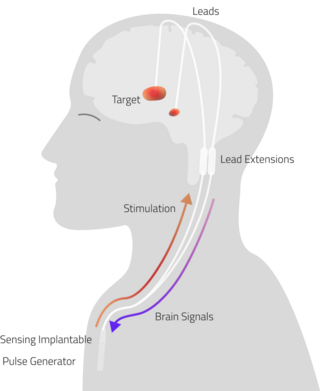Uses
Parkinson's disease

Parkinson's disease (PD) is a progressive degenerative disease of the basal ganglia, characterized by the loss of dopaminergic cells of the substantia nigra, pars compacta (SNc). [2] Surgical ablation has been used to treat Parkinson's disease. In the 1990s, the pallidum was a common surgical target. Unilateral pallidotomy improves tremor and dyskinesia on one side of the body (opposite the side of the brain surgery), but bilateral pallidotomy was found to cause irreversible deterioration in speech and cognition.[ citation needed ]
Two other rapidly evolving or potential surgical approaches to Parkinson's disease are deep brain stimulation (DBS) and restorative therapies. [2]
Deep brain stimulation is a surgical treatment involving the implantation of a neurostimulator medical device, sometimes called a 'brain pacemaker', which sends electrical impulses to specific parts of the brain. Generally, deep brain stimulation surgery is considered preferable to ablation because it has the same effect and is adjustable and reversible. [5]
The advent of deep brain stimulation has been an important advance in the treatment of Parkinson's disease. DBS may be employed in the management of medication-refractory tremor or treatment-related motor complications, and may benefit between 4.5% and 20% of patients at some stage of their disease course. DBS at high frequency often has behavioral effects that are similar to those of lesioning.
In Australia, patients with PD are reviewed by specialized DBS teams who assess the likely benefits and risks associated with DBS for each individual. [2] The aim of these guidelines is to assist neurologists and general physicians identify patients who may benefit from referral to a DBS team. Common indications for referral are motor fluctuations and/or dyskinesias that are not adequately controlled with optimised medical therapy, medication-refractory tremor, and intolerance to medical therapy. Early referral for consideration of DBS is recommended as soon as optimised medical therapy fails to offer satisfactory motor control. [6]
The thalamus is another potential target for treating a tremor; in some countries, so is the subthalamic nucleus, although not in the United States due to its severe side effects. Stimulation of portions of the thalamus or lesioning has been used for various psychiatric and neurological conditions, and when practiced for movement disorders the target is in the motor nuclei of the thalamus. [2] Thalamotomy is another surgical option in the treatment of Parkinson's disease. However, rigidity is not fully controlled after successful thalamotomy, it is replaced by hypotonia. Furthermore, significant complications can occur, for example, left ventral-lateral thalamotomy in a right-handed patient results in verbal deterioration while right thalamotomy causes visual-spatial defects. [7] However, for patients for whom DBS is not feasible, ablation of the subthalamic nucleus has been shown to be safe and effective. [8] DBS is not suitable for certain patients. Patients with immunodeficiencies are an example of a situation in which DBS is not a suitable procedure. However, a major reason as to why DBS is not often performed is the cost. Because of its high cost, DBS cannot be performed in regions of the world that are not wealthy. In the case of such circumstances, a permanent lesion in the subthalamic nucleus (STN) is created as it is a more favourable surgical procedure. [9] The surgical procedure is going to be done on the non-dominant side of the brain; a lesion might be favored to evade numerous pacemaker replacements. More so, patients who gain relief from stimulation devoid of any side effects and need a pacemaker change may have a lesion performed on them in the same position. The stimulation parameters act as a guide for the preferred size of the lesion. [10] In order to identify the part of the brain that is to be destroyed, new techniques such as micro electrode mapping have been developed. [11]
Cluster headaches
Cluster headaches occur in cyclical patterns or clusters—which gives the condition of its name. Cluster headache is one of the most painful types of headache. Cluster headache is sometimes called the "alarm clock headache" because it commonly awakens you in the middle of the night with intense pain in or around the eye on one side of your head. The bouts of frequent attacks may last from weeks to months. When drug treatment fails, an invasive nerve stimulation procedure shows promise.[ citation needed ] Cluster headaches have been treated by ablation of the trigeminal nerve, but have not been very effective. Other surgical treatments for cluster headaches are under investigation. [12]
Psychiatric disorders
Ablative psychosurgery continues to be used in a few centres in various countries. [13] In the US there are a few centres including Massachusetts General Hospital that carry out ablative psychosurgical procedures. [14] Belgium, [13] the United Kingdom, [15] and Venezuela [16] are other examples of countries where the technique is still used. In the People's Republic of China, surgical ablation was used to treat psychological and neurological disorders, particularly schizophrenia, but also including clinical depression, and obsessive-compulsive disorder. [17] The official Xinhua News Agency has since reported that China's Ministry of Health has banned the procedure for schizophrenia and severely restricted the practice for other conditions. [18] In recent studies, Deep Brain Stimulation (DBS) is beginning to replace Ablative Brain Surgery for severe psychiatric conditions that are generally treatment resistant, such as obsessive-compulsive disorder. [19]











